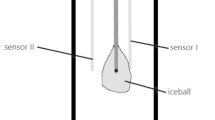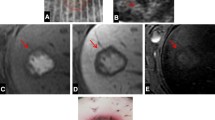Abstract
This study was designed to compare feasibility, safety, and effectiveness of microwave (MW) ablation versus radiofrequency (RF) ablation of lung tissue in a rabbit model. Twenty New Zealand White rabbits were submitted to MW (n = 10, group A) or RF ablation (n = 10, group B). The procedures were performed with a prototype MW ablation device with a 1.6-cm radiating section antenna (Valleylab MW Ablation System) and with a 2-cm exposed-tip RF electrode (Cool-tip RF Ablation System). At immediate computed tomography increase in density, maximum diameters (D1–D3) of ablation zones were measured and ablation volume was calculated. Histopathologic assessment was performed 3 and 7 days after the procedure. Technical success was achieved in nine of 10 rabbits in each group. One death occurred in group B. Complications included pneumothorax (group A, n = 4; group B, n = 4), abscess (group A, n = 1; group B, n = 1), and thoracic wall burn (group A, n = 4). No significant differences were demonstrated in attenuation increase (P = 0.73), dimensions (P = 0.28, 0.86, 0.06, respectively, comparing D1–D3) and volume (P = 0.17). At histopathology, ablation zones were similar, with septal necrosis, edema, hemorrhage, and peripheral lymphocytic infiltrate. Complete thrombosis of more than 90% of vessels up to 2 mm in diameter was depicted at the periphery of the ablation zone in group A specimens. In group B specimens, complete thrombosis was depicted in 20% of vessels. Feasibility and safety of MW and RF ablation are similar in a lung rabbit model. MW ablation produces a greater damage to peripheral small vessels inducing thrombosis.







Similar content being viewed by others
References
Goldberg SN, Gazelle GS, Mueller PR (2000) Thermal ablation therapy for focal malignancies: a unified approach to underlying principles, techniques, and diagnostic imaging guidance. AJR Am J Roentgenol 174:323–331
Lencioni R, Cioni D, Crocetti L et al (2005) Early-stage hepatocellular carcinoma in patients with cirrhosis: long-term results of percutaneous image-guided radiofrequency ablation. Radiology 234:961–967
Siperstein AE, Berber E, Ballem N, Parikh RT (2007) Survival after radiofrequency ablation of colorectal liver metastases: 10-year experience. Ann Surg 246:559–565
Herrera LJ, Fernando HC, Perry Y et al (2003) Radiofrequency ablation of pulmonary malignant tumors in nonsurgical candidates. J Thorac Cardiovasc Surg 125:929–937
Lencioni R, Crocetti L, Cioni R et al (2004) Radiofrequency ablation of lung malignancies: where do we stand? Cardiovasc Intervent Radiol 27:581–590
de Baere T, Palussiere J, Auperin A et al (2006) Midterm local efficacy and survival after radiofrequency ablation of lung tumors with minimum follow-up of 1 year: prospective evaluation. Radiology 240:587–596
Simon CJ, Dupuy DE, DiPetrillo TA et al (2007) Pulmonary radiofrequency ablation: long-term safety and efficacy in 153 patients. Radiology 243:268–275
Lencioni R, Crocetti L, Cioni R et al (2008) Response to radiofrequency ablation of pulmonary tumours: a prospective, intention-to-treat, multicentre clinical trial (the RAPTURE study). Lancet Oncol 9:621–628
Goldberg SN, Gazelle GS, Solbiati L, Rittman WJ, Mueller PR (1996) Radiofrequency tissue ablation: increased lesion diameter with a perfusion electrode. Acad Radiol 3:636–644
Organ LW (1976–1977) Electrophysiologic principles of radiofrequency lesion making. Appl Neurophysiol 39:69–76
Lu DS, Raman SS, Vodopich DJ, Wang M, Sayre J, Lassman C (2002) Effect of vessel size on creation of hepatic radiofrequency lesions in pigs: assessment of the “heat sink” effect. AJR Am J Roentgenol 178:47–51
Lu DS, Yu NC, Raman SS et al (2005) Radiofrequency ablation of hepatocellular carcinoma: treatment success as defined by histologic examination of the explanted liver. Radiology 234:954–960
Skinner MG, Iizuka MN, Kolios MC, Sherar MD (1998) A theoretical comparison of energy sources—microwave, ultrasound and laser—for interstitial thermal therapy. Phys Med Biol 43:3535–3547
Stauffer PR, Rossetto F, Prakash M, Neuman DG, Lee T (2003) Phantom and animal tissues for modelling the electrical properties of human liver. Int J Hyperthermia 19:89–101
Wright AS, Lee FT Jr, Mahvi DM (2003) Hepatic microwave ablation with multiple antennae results in synergistically larger zones of coagulation necrosis. Ann Surg Oncol 10:275–283
Shock SA, Meredith K, Warner TF et al (2004) Microwave ablation with loop antenna: in vivo porcine liver model. Radiology 231:143–149
Fry WA, Phillips JL, Menck HR (1999) Ten-year survey of lung cancer treatment and survival in hospitals in the United States: a national cancer data base report. Cancer 86:1867–1876
Goldberg SN, Solbiati L, Hahn PF et al (1998) Large-volume tissue ablation with radiofrequency by using a clustered, internally cooled electrode technique: laboratory and clinical experience in liver metastases. Radiology 209:371–379
Denys AL, De Baere T, Kuoch V et al (2003) Radio-frequency tissue ablation of the liver: in vivo and ex vivo experiments with four different systems. Eur Radiol 13:2346–2352
Simon CF, Dupuy DE, Mayo-Smith WW (2005) Microwave ablation: principles and applications. Radiographics 25:S69–S83
Deardorff DL, Diederich CJ, Nau WH (2001) Control of interstitial thermal coagulation: comparative evaluation of microwave and ultrasound applicators. Med Phys 28:104–117
Liang P, Dong B, Yu X et al (2001) Computer-aided dynamic simulation of microwave-induced thermal distribution in coagulation of liver cancer. IEEE Trans Biomed Eng 48:821–829
Furukawa K, Miura T, Kato Y et al (2005) Microwave coagulation therapy in canine peripheral lung tissue. J Surg Res 123:245–250
Wright AS, Sampson LA, Warner TF, Mahvi DM, Lee FT Jr (2005) Radiofrequency versus microwave ablation in a hepatic porcine model. Radiology 236:132–139
Hines-Peralta AU, Pirani N, Clegg P et al (2006) Microwave ablation: results with a 2.45-GHz applicator in ex vivo bovine and in vivo porcine liver. Radiology 239:94–102
Acknowledgments
The authors thank Prof. Carlo Bartolozzi, Chairman of the Division of Radiodiagnostic, for the general support given for the conduction of this research project.
Conflict of Interest Statement
The authors declare that they have no conflict of interest.
Author information
Authors and Affiliations
Corresponding author
Rights and permissions
About this article
Cite this article
Crocetti, L., Bozzi, E., Faviana, P. et al. Thermal Ablation of Lung Tissue: In Vivo Experimental Comparison of Microwave and Radiofrequency. Cardiovasc Intervent Radiol 33, 818–827 (2010). https://doi.org/10.1007/s00270-010-9869-z
Received:
Accepted:
Published:
Issue Date:
DOI: https://doi.org/10.1007/s00270-010-9869-z




